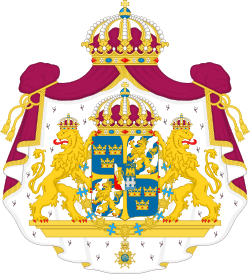Swedish Gold Coast
| Swedish Gold Coast | ||||||||||||
| Cabo Corso Svenska Guldkusten | ||||||||||||
| Swedish colony | ||||||||||||
| ||||||||||||
| ||||||||||||
 Map of Sweden Overseas Territories and Territorial Entities | ||||||||||||
 Historic map of the Gold Coast | ||||||||||||
| Capital | Fort Christiansborg | |||||||||||
| Languages | Swedish | |||||||||||
| Political structure | Colony | |||||||||||
| King/Queen of Sweden | ||||||||||||
| • | 1632–1654 | Christina of Sweden | ||||||||||
| • | 1654–1660 | Charles X Gustav of Sweden | ||||||||||
| • | 1660–1697 | Charles XI of Sweden | ||||||||||
| Administrator | ||||||||||||
| • | 1650–1656 | Henrik Carloff | ||||||||||
| • | 1656–1658 | Johan Filip von Krusenstierna | ||||||||||
| • | 1659–1660 | Johan Filip von Krusenstierna | ||||||||||
| • | 1663 | Tönnies Voss | ||||||||||
| Historical era | Colonial period | |||||||||||
| • | Established | 1650 | ||||||||||
| • | Danish conquest | 1658 | ||||||||||
| • | Treaty of Copenhagen | 1660 | ||||||||||
| • | Fall | 1663 | ||||||||||
| ||||||||||||
| Today part of | | |||||||||||
The Swedish Gold Coast (Swedish: Svenska Guldkusten) was a Swedish colony founded in 1650 by Hendrik Carloff on the Gulf of Guinea in present-day Ghana in Africa. It lasted until April 1663 when the whole Swedish Gold Coast was seized by Denmark, and integrated in the Danish Gold Coast.
Geography
The colony consisted of only a few forts and trading posts scattered around Cabo Corso (present-day Cape Coast) along the coast on the Gulf of Guinea in what later would become the British Gold Coast then Ghana.
The colony consisted of fortifications and trading posts (factories):
- Fort Carlsborg (also Carolusborg and Cape Coast Castle), present day Cape Coast, Central Region, under Swedish administration 22 April 1650 – January/February 1658, 10 December 1660 – 22 April 1663.
- Fort William (also Annamabo), present day Anomabu, Central region, under Swedish administration 1650 – 1657
- Fort Batenstein (also Batensteyn), present day Butri near Sekondi-Takoradi, Western region, under Swedish administration 1650 – 1656
- Fort Christiansborg (also Fort Frederiksborg and Osu Castle), present day Osu, Ghana in Accra, headquarters, under Swedish administration 1652 – 1658
- Fort Witsen (also Taccorari), present day Sekondi-Takoradi, Western region, under Swedish administration 1653 – 1658
- Fort Apollonia, present day Beyin, Western region, under Swedish administration 1655 – 1657
- Gemoree Factory
- Accara Factory
Colonial heads
Each of the three Swedish administrators had a different gubernatorial title:
- Director: Hendrik Carloff, 22 April 1650 – 1656
- Governor: Johan Filip von Krusenstierna (son of Philipp Crusius), 1656 – February 1658, 1659 – 1660
- Commander: Tönnies Voss, 16 – 22 April 1663
History
Following the foundation of the Swedish Africa Company (1649) by Louis de Geer an expedition under the command of Hendrik Carloff was sent to Africa in 1650. Carloff made a treaty with the Akan King of Futu (also Feta) on selling some areas of land. On 22 April 1650 the Swedish Gold Coast was founded and Carloff became its first administrator. In 1652 the foundations were laid of the fort Carlsborg
In 1656 Johan Filip von Krusenstierna (brother of the greatgrandfather of Adam Johann von Krusenstern)[1] was appointed the new Governor. This enraged Carloff. He left Cabo Corso only to return on 27 January 1658 on the Danish Privateer Glückstadt. Fort Carlsborg was seized and made part of the Danish Gold Coast colony.
King Charles X Gustav of Sweden made this one of his reasons to go to war with Denmark. After the Treaty of Copenhagen in 1660 Cabo Corso Castle was to be returned to Swedish administration: However it then was revealed that Carloff's associate Samuel Schmidt or Smith had already sold the colony in April 1659 to the Dutch West India Company on his own, and had disappeared with the gold to Angola.
Later on the local population started a successful uprising against their new masters and in December 1660 the King of the Akan people subgroup-Efutu again offered Sweden control over the area. A new expedition was sent to the colony which remained under Swedish administration only for a short period. Von Krusenstierna was reappointed as administrator.
On 20 April 1663 Fort Carlsborg and the capital Fort Christiansborg again were seized by the Danes after a long defense under the Swedish commander Anton Voss.
On 9 May 1664 the area again was seized, this time by Robert Holmes who made it part of the British Gold Coast colony.
References
- ↑ (German) Baltic nobility genealogy handbook Governor Johan Filip von Krusenstierna family


.jpg)
.svg.png)